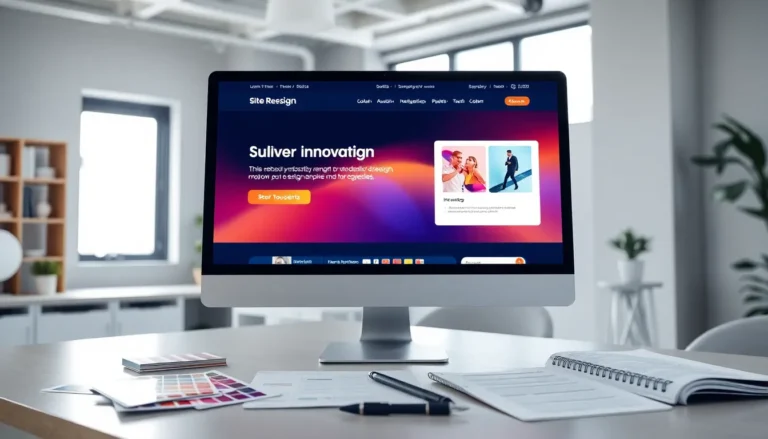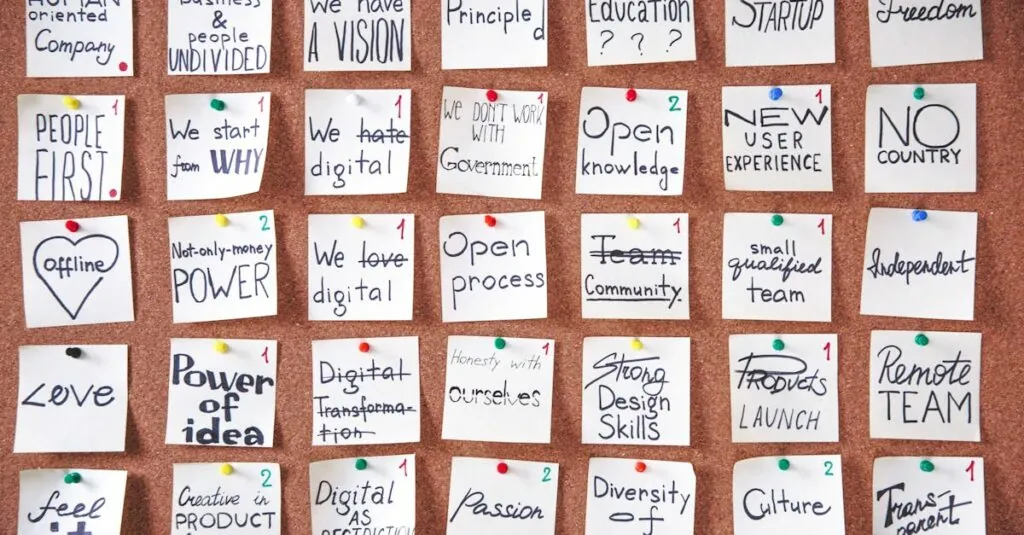Table of Contents
ToggleIn the digital age, a website isn’t just a collection of pages; it’s the virtual handshake that welcomes visitors. If the design doesn’t dazzle, they might just turn around and leave faster than you can say “bounce rate.” Understanding site design concepts is essential for anyone looking to create an engaging online presence that captures attention and keeps users coming back for more.
Overview of Site Design Concepts
Site design concepts encompass various principles that contribute to effective website creation. Key elements include layout, color schemes, typography, and navigation. Effective layout organizes content logically, guiding users effortlessly through information. Color schemes set the mood, influence emotions, and enhance brand identity. Typography impacts readability and conveys personality, making text visually appealing.
Navigation serves as a roadmap for users, enabling effortless access to different sections of the site. Intuitive navigation aids in finding information quickly, reducing frustrations and avoiding high bounce rates. Incorporating responsive design ensures compatibility across devices, enhancing user experience on smartphones and tablets.
User experience (UX) focuses on satisfying visitors by ensuring that interactions are smooth and enjoyable. Engaging visuals like images and videos can break up text, maintain interest, and illustrate key points. Consistency in design elements fosters familiarity, enabling users to navigate with ease.
Accessibility plays a crucial role in site design concepts, ensuring content is usable for everyone, including individuals with disabilities. Implementing alt text for images and using high-contrast colors can significantly enhance inclusivity. Site performance, including loading speed, affects user satisfaction; slow sites contribute to higher abandonment rates.
SEO considerations are essential in site design concepts. Optimizing elements like titles, meta descriptions, and alt attributes improves visibility in search engines, drawing more visitors. Incorporating analytics helps track user behavior, allowing for adjustments based on real-time data.
Understanding site design concepts equips individuals with the tools necessary to create visually appealing and functional websites. Prioritizing these elements ensures that websites engage visitors effectively and achieve desired goals.
Key Principles of Site Design
Effective site design combines functionality and aesthetics to create an engaging user experience. Understanding these principles helps design websites that attract and retain visitors.
Functionality
Functionality focuses on how well a site operates. An intuitive layout allows users to navigate easily and find information without frustration. Quick loading speeds enhance engagement by reducing wait times. Integration of interactive features, such as forms and chatbots, encourages user interaction. Responsive design ensures compatibility across various devices, accommodating different screen sizes. Regular updates maintain website performance, keeping content fresh and relevant. Users appreciate when a site meets their needs effectively, resulting in longer visits and lower bounce rates.
Aesthetics
Aesthetics play a vital role in creating a pleasing visual experience. Color schemes should reflect brand identity while evoking the desired emotional response. Typography impacts readability and helps convey a brand’s personality through font choices. Visual hierarchy directs users’ attention to important elements, enhancing the overall user experience. Consistency in design elements fosters familiarity, making navigation intuitive. Engaging visuals, including images and graphics, sustain interest throughout the browsing experience. When aesthetics align with functionality, the site resonates with users, encouraging repeat visits.
Elements of Effective Site Design
Effective site design incorporates various elements that enhance user experience. Understanding these components fosters the creation of engaging websites.
Layout and Structure
An organized layout ensures visitors navigate content intuitively. Logical grouping of related elements streamlines access, keeping users focused on the desired information. Grids simplify the alignment of visuals and text, promoting clarity. Responsive design adapts layouts to different screen sizes, facilitating seamless interactions across devices. Hierarchical structures, such as headings and subheadings, guide users through the content, paired with ample white space to reduce clutter. Each of these features contributes to a more enjoyable browsing experience, ultimately improving retention rates.
Color Schemes and Typography
Color schemes enhance brand identity and evoke emotional responses. A balanced palette utilizes complementary colors, ensuring visual harmony. Typography impacts readability and influences first impressions. Choosing fonts that align with branding reinforces personality while ensuring legibility. Consistent font sizes and styles guide user focus, making important information stand out. Incorporating sufficient contrast aids visibility, particularly for accessibility needs. Thoughtful use of color and typography together creates an inviting atmosphere that encourages user engagement and enhances overall design effectiveness.
User Experience and Accessibility
User experience (UX) is critical for ensuring visitors engage meaningfully with a website. It encompasses elements that contribute to smooth interactions and a satisfying browsing experience. Intuitive navigation serves as a guiding framework, making it easy for users to find information quickly.
Accessibility plays a vital role in creating an inclusive environment for all users. Implementing features like alt text for images and high-contrast colors ensures that everyone can navigate the site effectively. Websites should accommodate individuals with visual impairments, cognitive disabilities, or other challenges.
Responsive design significantly enhances user experience across various devices. Those accessing the site from smartphones or tablets often expect seamless transitions between screens. Adapting layouts and images to fit different sizes ensures consistent usability, which decreases bounce rates.
Loading speed impacts both user satisfaction and engagement. A delay of even a few seconds can deter visitors from exploring further. Prioritizing fast load times through optimized images and streamlined coding fosters a positive first impression.
Consistent design elements also contribute to a sense of familiarity and ease for users. Repeating colors, fonts, and layout styles throughout the site helps visitors quickly acclimate and navigate effectively. This consistency reinforces brand identity while making the user journey more cohesive.
Data-driven analysis is essential for improving UX and accessibility. By utilizing analytics tools, site owners can track user behavior patterns and identify areas needing improvement. Regularly assessing and updating design features ensures that accessibility standards and user experiences align with evolving best practices.
Emerging Trends in Site Design
Innovative approaches to site design continue to emerge, reflecting evolving technologies and user expectations. Minimalism is gaining popularity, as simpler designs often enhance user experience. Users appreciate clean interfaces that remove distractions and focus on essential content.
Dark mode has become a favored choice among developers and users alike. It reduces eye strain in low-light environments while providing a sleek aesthetic. Focus remains on design versatility, allowing sites to adapt to individual user preferences.
Microinteractions play a significant role in engaging visitors. These subtle animations and feedback mechanisms enhance interactive elements. When users click buttons or undergo a change in navigation, small visual cues guide them through their journey, resulting in a more enjoyable experience.
Voice user interfaces are progressively gaining traction. Users now seek more natural interactions with technology using voice commands. Incorporating this technology offers accessibility and enhances engagement for users who prefer verbal communication.
Personalization remains a crucial factor in user retention. Tailoring content based on visitor behavior creates a more relevant experience. Dynamic elements respond to user preferences, making each visit unique and meaningful.
Sustainability in web design is attracting attention as well. Designers increasingly prioritize eco-friendly hosting options and efficient coding practices. These choices minimize energy consumption while contributing to a reduced carbon footprint.
Staying current with responsive design is vital for accommodating diverse devices and screen sizes. Effective designs ensure compatibility from desktops to smartphones, enhancing user satisfaction and engagement. Integrating these emerging trends fosters a holistic web experience that resonates with users, ultimately driving site success.
Mastering site design concepts is essential for anyone looking to establish a compelling online presence. By focusing on elements like layout color schemes and navigation, creators can significantly enhance user experience. Prioritizing responsive design and accessibility ensures that websites cater to a diverse audience.
Staying updated with emerging trends like minimalism and personalization can further refine a site’s effectiveness. Regular assessments and data-driven adjustments keep content relevant and engaging. Ultimately, a well-designed website not only attracts visitors but also fosters lasting connections and drives success.







